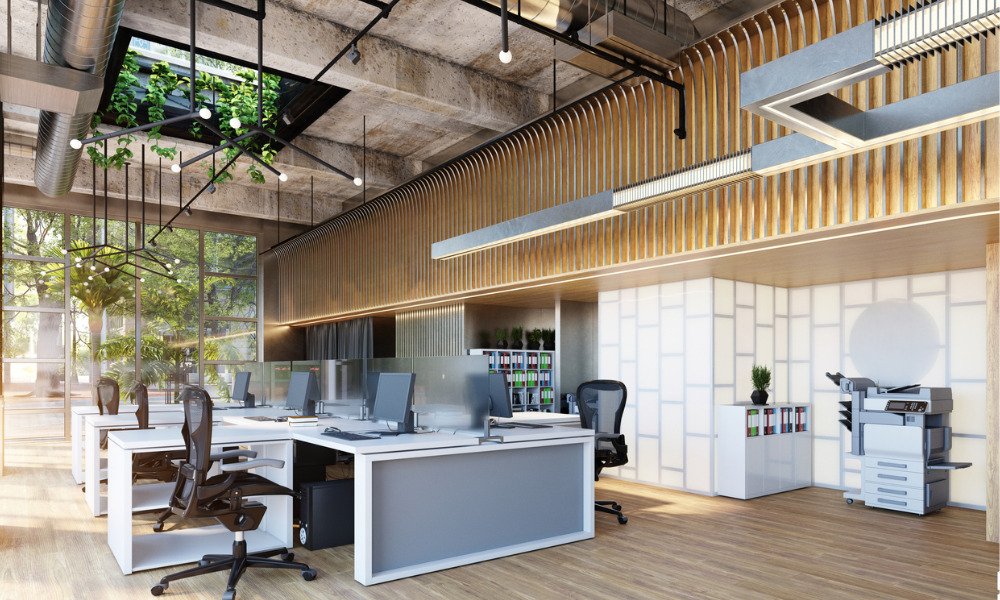Employers might want to consider biophilic design as a study indicates it can improve holistic wellness and key cognitive functions

Employer revamping their work-places as part of the “new normal” may want to consider incorporating biophilic design, which is about focusing on natural elements such as air quality, access to daylight, indoor plants and items made of natural materials to better connect people with nature.
That’s because a recent study suggests these elements could help reduce workers’ stress while improving their creativity.
“Indoor nature can play a very important role,” says Jie Yin, Yerby fellow in the Department of Environmental Health at the Harvard T.H. Chan School of Public Health in Boston. “Usually, office space is a stressful place and if you give this kind of biophilic intervention, it can help reduce their stress and boost their cognitive function in a tangible way.”
Boost in creativity, but also distraction
The study involved 30 participants who experienced three environments featuring biophilic elements — green plants and biomorphic shapes and patterns — and one controlled environment as a base, in virtual reality (VR). Eye-tracking technology was also used to gauge people’s individualized exposure to biophilic design.
“We saw positive improvements in blood pressure, heart rate and heart rate variability, as well as skin conductance level, which is the body's physical reaction to stress — so really important improvements in our physical health,” says Heather Greene, senior associate and workplace leader at design firm Stantec in Detroit, which sponsored the research.
“We also saw in the cognitive scores that the divergent paths — which are really associated with the creative brain functions — improve after working in the biophilic environment.”
However, researchers were surprised to find that the biophilic elements may adversely affect attention-intensive reaction times. In other words, these features can have a calming influence that leads to more creative thinking but can also distract people from focusing on their tasks.
“We thought that if you have biophilic natural elements in your office, you’re probably more focused on your work. But we saw that might be the distraction… [People] may pay more attention on their surrounding environment rather than the task,” says Yin.
“The takeaway is that when you design your office, you have to… give the priority to your purpose. If you are in an enclosed small space, if you want to get things done, if you want to focus, you probably don't want to include too many biophilic elements. But… if you want to have nice communication with your colleagues, if you want to think something creative, you probably want to incorporate more and different patterns of biophilic in this space.”
In looking at the data, you can see how relaxed participants were with the biophilic elements, says Greene.
“These convergent brain paths are asking you to compute and really process through something quickly and correctly, where the divergent paths are asking you to brainstorm, innovate and create. So, what does that mean from an employer standpoint? I think it further supports the need to have a variety of spaces and start to think about enabling your teams to choose the space that best suits the tasks they're trying to accomplish. So, it pushes back on this one-size-fits-all mentality that we’ve had in design for a long time and really starts to open the door to: ‘What works best for me as an individual? Which space can I choose that optimizes what I'm trying to produce?’”
Employee wellness amid pandemic
One of the silver linings of the COVID-19 pandemic has been a reset and focus on wellness, says Greene.
“It’s pivotal that we consider not just the physical health requirements to mitigate a virus — that’s paramount — but also the mental health aspect of asking people to return to workspaces in a way that makes them feel safe and makes them feel appreciated... Employees are going to look to workspaces and their employers to do more than just provide them with a desk and a computer but really support their holistic well-being.”
Many people are returning to the office with unease, and employers can help mitigate that fear by communicating what has been done in a clear, concise method, she says.
“One path that you could go down is orange safety cones and everything is blocked off and barricaded, and everyone sits in a plexiglass fishbowl. But… while some of those are really great strategies to mitigate a virus, that doesn't address the mental health offset, that triggers a fear response.”
Instead, employers can start to embrace design to communicate safety, says Greene. For example, they can use patterns and changes in flooring materials to indicate distance requirements or use mobile glass partitions that mimic nature to create a respite environment.




